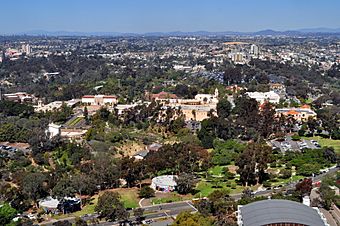El Prado Complex facts for kids
Quick facts for kids |
|
|
El Prado Complex
|
|

Aerial view of El Prado Complex from the south
|
|
| Lua error in Module:Location_map at line 420: attempt to index field 'wikibase' (a nil value). | |
| Location | Balboa Park, San Diego, California |
|---|---|
| Area | 13 acres (5.3 ha) |
| Built | 1935 |
| Architect | Goodhue, Bertram G.; Winslow, Carelton M. |
| Architectural style | Mission Revival, Spanish Baroque |
| NRHP reference No. | 76000515 |
| Added to NRHP | December 12, 1976 |
The El Prado Complex is a special area in Balboa Park in San Diego, California. It is known as a historic district, which means it's a place with important old buildings. This complex covers about 13 acres (5.3 hectares). It includes 13 important buildings and one structure that have historical value.
Most of these buildings were first built for a big event called the Panama-California Exposition in 1915–16. This was like a huge fair or celebration. Later, many of them were fixed up and used again for another fair, the California Pacific International Exposition, in 1935–36. The main architects who designed these beautiful buildings were Bertram Goodhue and Carleton Winslow. Because of its historical importance, the El Prado Complex was added to the National Register of Historic Places in 1976.
What You'll Find at El Prado
The El Prado Complex has many interesting parts. Here are some of the main ones:
Cabrillo Bridge
- The Cabrillo Bridge was built in 1915. It crosses over a canyon and was the main way to enter the fair and Balboa Park. It looks almost the same today as it did back then.
Alcazar Garden
- The Alcazar Garden was created for the 1915 fair. It was first called Montezuma's Gardens. For the 1935 fair, its name was changed to Alcazar Gardens. It's a beautiful place to relax.
Spreckels Organ Pavilion
- The Spreckels Organ Pavilion was also built for the 1915 fair. It has a very large outdoor organ. This amazing structure has stayed mostly the same since it was first built.
Plaza de Panama
- The Plaza de Panama is an open area. It is surrounded by important buildings like the San Diego Museum of Art, the Timken Museum of Art, the House of Hospitality, and the House of Charm. It was originally a walking area. For some time, it was used for parking cars. Now, it is being changed back into a pedestrian plaza for people to enjoy.
El Prado Arcade
- The El Prado Arcade is a long, covered walkway. It has many arches along its path. It looks much like it did in 1915, except for some repairs over the years.
Botanical Building
- The Botanical Building is a special structure with a lath (wooden strips) roof. It has two reflecting pools outside. It was built for the 1915 fair and used again in 1935 without many changes. It's a great place to see plants.
House of Charm
- The House of Charm was first built for the 1915 fair as the Indian Arts Building. It was meant to be a temporary building. For the 1935 fair, it became the House of Charm. The original building was taken down in the 1990s because it was unsafe. A new one was built exactly like the old one.
House of Hospitality
- The House of Hospitality was also built for the 1915 fair. It was originally the Foreign Arts Building. Like the House of Charm, it was meant to be temporary. It was renamed for the 1935 fair. The original building was taken down in the 1990s and rebuilt to look the same.
Casa del Prado
- The Casa del Prado was first the Varied Industries Building for the 1915 fair. It was also meant to be temporary. It housed the San Diego Aerospace Museum for a few years. The original building was taken down in the 1960s. A new building was constructed using the old one as a guide.
Electrical Building / Casa de Balboa
- The Electrical Building was first known as the Commerce and Industries Building in 1915. It was also a temporary structure. It later became the Palace of Better Housing for the 1935 fair. After the fair, it was called the Electrical Building. The San Diego Aerospace Museum was located here for some time. Sadly, it burned down in 1978. A new building, called Casa de Balboa, was built in its place.
San Diego Museum of Art
- The San Diego Museum of Art was built in 1926. It stands where the 1915 Sacramento Valley Building used to be. That earlier building was temporary and was taken down in 1924.
San Diego Natural History Museum
- The San Diego Natural History Museum building was built in 1933. It is on the site of the 1915 Southern California Counties building. That building was later used as a Civic Auditorium and burned down in 1925. The new museum building was called the Palace of Natural History during the 1935 fair.
Map of the Area
The El Prado Complex is centered around El Prado, which was the main avenue of the Panama-California Exposition in 1916. It includes the central avenue itself, along with the buildings and open spaces on both sides. The area near the Cabrillo Bridge, called the California Quadrangle, is also a historic site.
Images for kids
See also
 In Spanish: El Prado Complex para niños
In Spanish: El Prado Complex para niños











